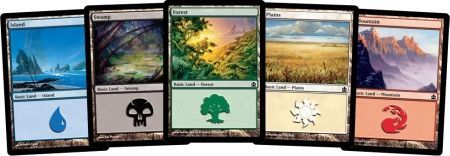
Featured Blog | This community-written post highlights the best of what the game industry has to offer. Read more like it on the Game Developer Blogs.
Card Games - How Randomness Defines Your Game
Randomness is a key element in any card game and a hotly debated topic in the world of game design. In this article I discuss how different forms of and approaches to randomness can define the nature of a card game.

So, I think it should probably be clear by now that I tend to write a lot about card games. With a focus like that, it was inevitable that the topic of randomness would eventually come up. Randomness is one of those issues that seems like it will be debated for all eternity, but I'm not here to argue for or against randomness - that's an article for another time. Instead, I'd like to talk about a less frequently discussed topic: how randomness can determine the nature of your card game.
Two Schools
Looking at the crop of current card games, I think that the approach to randomness can be divided into two main groups. These groups have different ideas of not only how randomness impacts the game, but also when it impacts the game.
Random Draw
With this approach, randomness is mostly centralized in the act of drawing cards. In Magic, players have 60 card decks. A deck can contain up to four copies of any one card, but players will often use three, two, or even singleton copies of cards. This makes the chances of you drawing a specific card pretty slim. Among these cards are land cards, which provide you the resource (mana) you need to play other cards but generally don’t impact the game outside of that function. You can only play one land card per turn and there are different types of land, which produce different types of mana. This can lead to two very unpleasant scenarios. First is "mana screw," where you either aren’t drawing enough land cards or aren’t drawing enough land cards of a certain type, which leaves you without enough mana to play your cards. The second is "mana flood," which is where you draw too many land cards and have nothing to actually play.

The philosophy of this approach could best be summarized as “Here’s your card. What do you do now?” The randomness serves to challenge players by forcing them to adapt and see the best line of play available to them based on their randomized cards. The cards themselves generally do not have random effects and can be expected to be consistent in function, which allows for easier strategizing. However, the nature of mana flood and mana screw can lead to players being entirely locked out of the game.
Magic: the Gathering follows Random Draw.
Random Effect
Randomness through card draw still exists here, but it is reduced. Decks are smaller, which can make draws slightly more consistent. Another big difference is the lack of land cards – resources are given to players steadily and automatically, which completely removes mana screw/flood. However, this can make games too consistent, so developers have added effects to cards that are randomized. Here are some examples:


The randomness here is focused on the effects of cards that you have already drawn and played. The consistency of the resource system and card draw means that you’re far less likely to be locked out of the game, but the randomness of the effects makes strategizing much more difficult. Strategy requires forward-thinking, and you can’t predict future game states when random effects are involved. This can also reduce games into a coin flip – you could be playing well throughout a match, only to have your almost assured victory be stolen away by a lucky Ragnaros shot.
Hearthstone follows Random Effect.
Critical Mass
Two important questions that card game designers should ask themselves are “How frequent is randomness in this game?” and “How big is its impact?” I think that for the most part, games fall somewhere on a gradient between two points.
Low Frequency, High Impact
You don’t see randomness very often, but one really bad draw can shape the entirely of the match.
When you have low frequency and high impact, the game can be more strategic and competitive because players have a greater degree of agency. However, those high impact situations can swing games between exhilarating victories and miserable defeats. It can also lead to some very sore losers.
Magic: the Gathering leans towards low frequency, high impact.
High Frequency, Low Impact
Randomness is very common with this arrangement. The impact of the randomness can vary quite a bit from card to card, but the sheer quantity of it reduces and evens out its general impact.
When you have high frequency and low impact, some players can be more willing to accept the randomness simply because it’s unavoidable. It can also make strategizing more difficult and inconsistent, thereby making the game less competitive. Taken to an extreme, it can make the game feel almost like a party game where both players recognize that their actions aren’t particularly meaningful and, as a result, don't take the game's outcomes seriously. It can also turn off players that equate more random effects to more randomness, even though random acts become more consistent the higher the sample size is.
Hearthstone leans towards high frequency, low impact.
More or Less
The final topic I'll touch on here is the designer's approach to randomness: is randomness something you work to suppress, or something you work to encourage?
Limiting Randomness
This perspective attempts to give players ways to work against the randomness inherent in card games. A good example of this would be the Scry mechanic from Magic. Scry lets you look at cards from the top of your deck and then lets you put any of them on the top or the bottom of your deck in any order. This gives you the ability to filter out cards you don't want and stack your upcoming draws.

Limiting randomness in this way can make the game more strategic not just by reducing randomness, but by forcing the player to make important decisions. You can also work to limit randomness via omission by not implementing effects or mechanics that heavily rely on or produce randomness. Also, it's very important to note that limiting randomness is not the same as antagonizing it.
Magic: the Gathering works to limit randomness.
Encouraging Randomness
This perspective works to add additional randomness to the game. The idea here is that randomness makes the game more interesting by making play sessions more varied and unpredictable. Designers may hold this opinion for a number of reasons. Maybe they think the game is boringly consistent, or maybe they decide that the tension and heightened emotions that randomness can create make for a more compelling game environment.
Hearthstone works to encourage randomness.
![]()
Think on It
With randomness being inherent in card games, I think that us card designers should think more about how to wield it with intention in our designs. Remember that randomness is not an enemy - it's a tool. I hope that this article has been helpful to you, and I hope that you put some serious thought to how randomness shapes your card games.
Read more about:
Featured BlogsAbout the Author(s)
You May Also Like









